Finland is a country in northern Europe famous for its scenic beauty. Thousands of lovely lakes dot Finland’s landscape, and thick forests cover about 65 percent of the land. The country has a long, deeply indented coast, marked by colorful red and gray granite rocks. Thousands of scenic islands lie offshore.

Sweden lies to the west of Finland, northern Norway lies to the north, and Russia lies to the east. The Gulf of Finland and the Gulf of Bothnia, two extensions of the Baltic Sea, border Finland on the south and southwest. The northernmost part of the country lies inside the Arctic Circle in a region called the Land of the Midnight Sun. In this region of Finland, the sun shines 24 hours a day for long periods each summer. Helsinki, the country’s capital and largest city, is in the south on the Gulf of Finland.

Most of Finland’s people live in the southern part of the country, where the climate is mildest. Finns love the outdoors and the arts. They have a high standard of living and receive many welfare benefits from the government.
Much of Finland’s wealth comes from its huge forests. They form the basis of the country’s thriving forest-products industry, which includes woodworking and the manufacture of paper and pulp.
Finland’s location between Russia on the east and Sweden on the west has played an important role in the country’s history. In the 1000’s, Sweden and Russia began to battle for possession of Finland. Sweden gradually gained control in the 1100’s and 1200’s, but conflict between Sweden and Russia over Finland continued for hundreds of years. Today, Swedish remains equal with Finnish as an official language of Finland. Russia controlled the country from 1809 until 1917, when Finland declared its independence. The nation became a republic with a president and parliament. During World War II (1939-1945), Finland fought two wars with the Soviet Union, which was formed under Russia’s leadership in 1922 and existed until 1991.
Government
Finland is a democratic republic. Its Constitution went into force in 2000, replacing the original constitution adopted in 1919. The Constitution guarantees the people such rights as freedom of speech, freedom of worship, and equality before the law. All Finns who are 18 and older may vote.
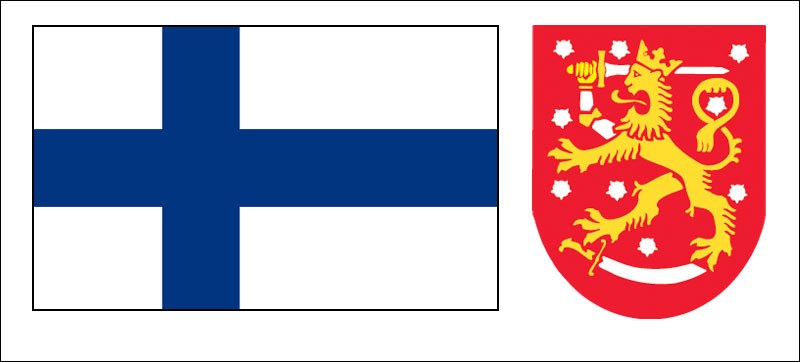
The president
is Finland’s head of state and chief executive. The president is elected to a six-year term by the people of Finland. If no candidate wins more than half of the votes cast, a runoff is held between the two most popular candidates. No president may serve more than two terms in a row.
The president may be reelected any number of times. The president may issue orders that do not violate existing laws, veto (reject) bills passed by the parliament, and dissolve the parliament and call for new elections. The president handles foreign relations and acts as head of the armed forces. The president makes decisions concerning war and peace, but the parliament must approve these decisions.
Loading the player...Finland's national anthem
The prime minister and Cabinet.
With the advice of parliament, the president appoints the prime minister, who is head of government. The prime minister, with the president’s approval, forms a Cabinet made up of members of several political parties. The political parties involved must agree on the Cabinet selections. Cabinet members head the government departments. The prime minister presides over the Cabinet and works with it in setting government programs, which must be acceptable to the parliament.
The parliament
of Finland is a one-house legislature called the Eduskunta (in Swedish, the Riksdag). The people elect its 200 members to four-year terms. The parliament creates the country’s laws and makes important decisions on the government budget and taxes. If the president vetoes a bill, the Eduskunta can override the veto and pass the bill by a simple majority vote.
Local government.
For purposes of local government, Finland is divided into 19 regions, plus the autonomous Aland Islands. The regions are subdivided into hundreds of municipalities. They range in size from thinly populated rural areas to large cities. A council elected by the people governs each municipality. Municipalities collect their own taxes to support hospitals, schools, and other local institutions.
Political parties.
Election to the Eduskunta is based on a system called proportional representation. This system gives a political party a share of seats in the parliament according to its share of the total votes cast in an election. The system encourages small parties to put up candidates and makes it hard for any one party to win a majority. As a result of proportional representation, a number of parties usually have seats in the Eduskunta. See Proportional representation.
The parties that generally receive the most votes are the Social Democratic Party, supported mostly by working-class and lower-middle-class voters; the centrist Center Party; and the conservative National Coalition Party. Other parties include the Christian Democrats, Finns Party, Green League, Left Alliance, and Swedish People’s Party.
Courts.
Finland’s highest court of appeal is the Supreme Court. Regional courts hear appeals from lower courts. Special courts handle such matters as impeachment of government officials and labor disputes.
Armed forces.
Finland has an army, navy, and air force. Healthy men between 18 and 60 must serve 6 to 12 months in the armed forces.
People
Ancestry and population.
About 90 percent of Finland’s people are Finnish by descent. Many of the rest are Estonian, Russian, or Swedish.
Most of Finland’s people live in the south, where the climate is less harsh. About five-sixths of all Finns live in cities and towns. Helsinki is the capital and largest city in Finland. The municipality of Helsinki has about 660,000 people. A municipality may include rural areas as well as the urban center. About 10 percent of the nation’s people live in the Helsinki municipality. See Helsinki.
Several thousand Sami (formerly known, to outsiders, as Lapps) live in Finland. Most of them live in the far northern part of the country. The Sami’s homeland, called Sapmi (also sometimes known as Lapland), stretches across much of far northern Finland, Norway, and Sweden. The ancestors of the Sami lived in Finland long before the first Finns arrived thousands of years ago. See Lapland; Sami. 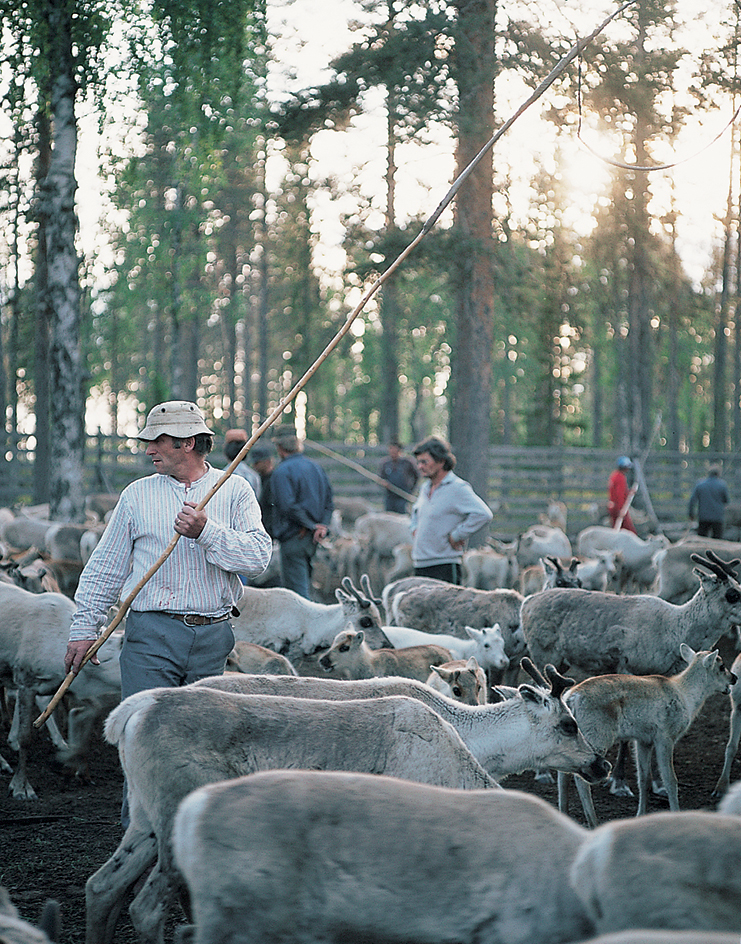
Languages.
Finland has two official languages—Finnish and Swedish. Most of the people speak Finnish, and many speak Swedish. Most of the Swedish-speaking people live on the south and west coasts and on the offshore Aland Islands. Finnish and Swedish belong to different language families. The Sami speak a language related to Finnish. See Language (Language families).
Way of life.
In Finland’s cities, most people own or rent apartments. Most people in rural areas live in one-family homes on farms or in villages.
The Finns enjoy eating fish, especially herring, perch, pike, and salmon. Popular meats include beef, veal, pork, and sausage. Smoked reindeer is a special treat. Boiled potatoes covered with butter and dill sprigs make up a favorite side dish. Butter and milk are important parts of the Finnish diet.
The most famous feature of Finnish life is a special kind of bath called a sauna. Most Finns take a sauna at least once a week for cleansing and relaxation. In a sauna room or bathhouse, stones are heated over a stove or furnace. The temperature in the sauna rises to between 176 and 212 °F (80 and 100 °C). Bathers sit or lie on wooden benches until they begin to perspire freely. They may throw water on the stones to produce vapor and make the sauna feel even hotter. They may beat themselves gently with leafy birch twigs to stimulate circulation. While taking a sauna, Finns relax and talk quietly. Typically, newspapers, televisions, and other distractions are not allowed. 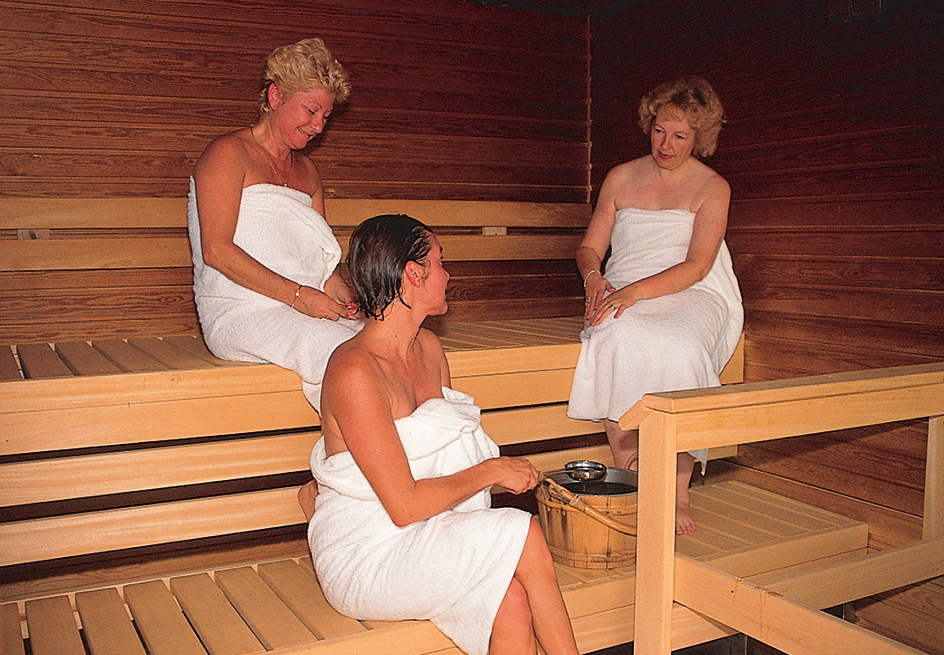
After heating up in the sauna, bathers take a cold shower or plunge into a lake. They may repeat the cycle of heating and cooling several times. When they are finished, they rest until their body returns to normal temperature.
Social welfare.
The government of Finland provides the people with many welfare services. Since the 1920’s, maternity and child welfare centers have given free health care to pregnant women, mothers, and children. Since 1948, families have received an allowance every time they have had a new baby as well as a yearly allowance for each child under the age of 16.
In 1939, Finland began an old-age and disability insurance program. This program guarantees monthly pensions to people 65 years and older and to permanently disabled citizens. In 1963, Finland set up a health insurance program for all citizens.
The government began to guarantee workers annual holidays in the 1920’s. Today, workers who remain in the same job for one year receive a 26-day annual vacation. After 10 years, they receive 36 days.
Recreation.
The Finns love outdoor sports. In winter, they enjoy ice hockey, ice skating, ski-jumping, cross-country skiing, and downhill skiing. Popular summer sports include pesapallo (a Finnish form of baseball), swimming, boating, and hiking. In summer, thousands of city families flock to their cottages and saunas on lakes, the seacoast, or the offshore islands. Favorite spectator sports include track-and-field events and ice hockey matches. The Finns also enjoy ballets, concerts, motion pictures, plays, and operas. 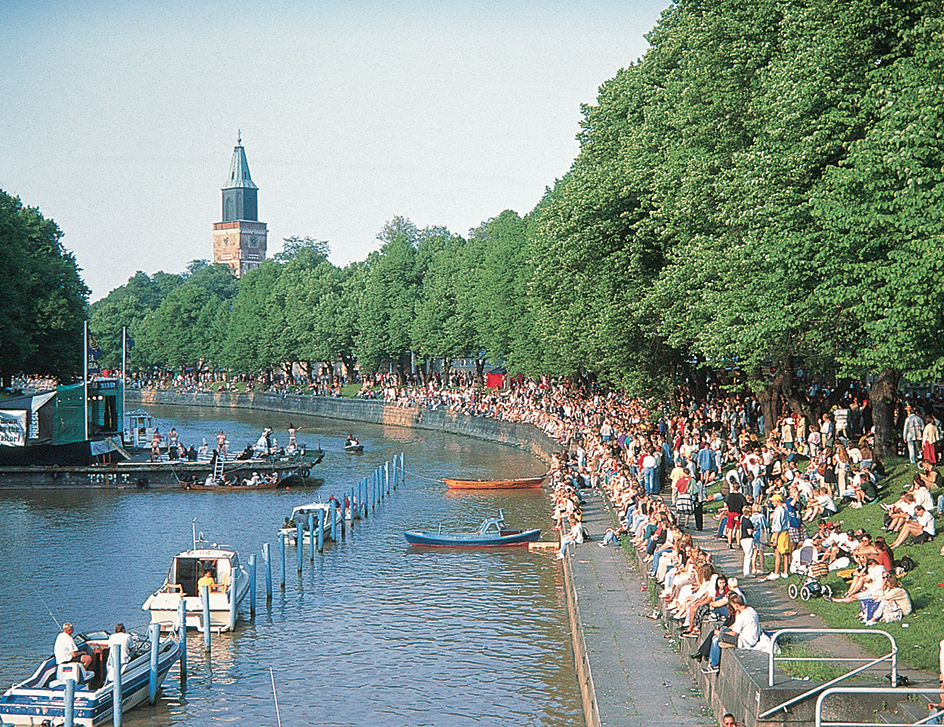
Education.
Almost all adult Finns can read and write. All elementary school students and most other students go to public schools. The rest attend private schools, which may charge a small tuition fee. Elementary school students receive one meal a day, books, and medical and dental care, all free of charge.
Finland has a comprehensive school system. Under this system, children are required to attend elementary schools called basic schools for nine years. They begin at the age of 7. They attend the lower level of the schools for six years and the upper level for three years.
After completing basic school, students may choose to enter an upper secondary school or a vocational school. Upper secondary schools, which offer three-year courses, emphasize academic subjects. Vocational schools, most of which offer two-year courses, emphasize education in skilled manual work.
Most vocational school students enter the job market after graduating. Graduates of upper secondary schools may apply to a polytechnical institute or a university. Polytechnical institutes chiefly prepare students for careers in business. The universities offer a wide variety of higher-education programs.
Finland has numerous universities and polytechnical institutes. The University of Helsinki is the country’s largest university.
Religion.
The Evangelical Lutheran Church is the state church of Finland, and the national government has supreme authority over it. But the people have complete freedom of worship. Most Finns are Evangelical Lutherans.
Many people do not belong to any religious group. Religions with small followings in Finland include various other Protestant churches and the Eastern Orthodox Church.
The arts.
Finland has a rich folk culture, which is reflected in the country’s crafts, literature, music, and painting. The person most responsible for preserving Finland’s oral folklore was Elias Lonnrot, a country doctor. He collected the centuries-old songs, poems, and chants of the Finnish peasants and assembled them into a collection published in 1835. This huge collection, called the Kalevala, became Finland’s national epic. Loading the player...
Finnish folk dance

During the 1800’s and 1900’s, the Kalevala inspired many artists. Akseli Gallen-Kallela used its themes in many paintings. Composer Jean Sibelius based most of his symphonic poems on the work. American poet Henry Wadsworth Longfellow patterned the rhythm of his poem The Song of Hiawatha on the Kalevala.
In the early 1800’s, Johan Ludvig Runeberg became known as Finland’s national poet. His poem “Vart Land” is the country’s national anthem. Other writers of the 1800’s include the novelist Aleksis Kivi and the playwright Minna Canth, an early champion of women’s rights. In the 1900’s, the novelists Frans Eemil Sillanpaa and Mika Waltari gained international fame. Sillanpaa won the Nobel Prize in literature in 1939.
Finnish glassware, ceramics, furniture, and textiles are world famous for the simple beauty of their design. This same simplicity of line and shape can be seen in the works of Finland’s best-known architects—Eliel Saarinen and Alvar Aalto. Saarinen’s famous designs include the railroad station and the National Museum in Helsinki. Aalto gained fame not only as an architect, but also as a town planner and furniture designer.
The land
Finland is largely a plateau broken by small hills and valleys and low ridges and hollows. The land rises gradually from south-southwest to north-northeast, but the average altitude is only 400 to 600 feet (120 to 180 meters) above sea level. Mount Haltia, the country’s highest point, stands 4,344 feet (1,324 meters) above sea level in the far northwestern region of Finland. About 60,000 lakes are scattered throughout the country, and forests cover almost two-thirds of the land.
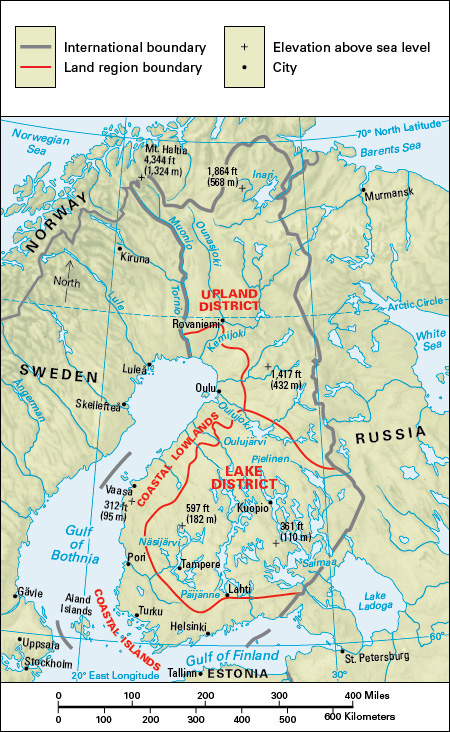
Land regions.
Finland has four main land regions: (1) the Coastal Lowlands, (2) the Lake District, (3) the Upland District, and (4) the Coastal Islands.
The Coastal Lowlands
lie along the Gulf of Bothnia and Gulf of Finland. Finland’s coastline is 1,462 miles (2,353 kilometers) long. Many small lakes lie in the Coastal Lowlands. The region has less forestland and a milder climate than the Lake and Upland districts have. The lowlands also have some of the country’s most fertile soil. As a result, the region offers the best conditions for farming. The Coastal Lowlands of the south have the mildest climate and the most productive farms. Most of Finland’s people live in this area.
The Lake District
occupies central Finland north and east of the Coastal Lowlands. The region has thousands of island-dotted lakes. The lakes cover about half the total area of the district. Narrow channels or short rivers connect many of the lakes. Saimaa, the largest lake in Finland, covers about 680 square miles (1,760 square kilometers) in the southeastern part of the region. The Saimaa Lake System, which is about 185 miles (298 kilometers) long, links several lakes in the area. A fleet of steamers travels the system, stopping at towns on the shores of the lakes. Forests of birch, pine, and spruce cover most of the land in the Lake District. Most farmlands in the region lie in the southwestern part of the Lake District.
The Upland District
is Finland’s northernmost and least densely populated region. It covers about 40 percent of the country. The Upland District has a harsher climate and less fertile soil than the other regions have. As one travels north through the Upland District, plant life becomes increasingly scarce. Stunted pines and arctic birches grow in parts of the district. However, the northernmost part makes up a tundra—a frozen, treeless plain.
Most of Finland’s hills rise in the Upland District. Swamps and marshlands separate the hills. Several rivers in the region provide energy for hydroelectric power stations.
The Coastal Islands
consist of thousands of islands in the Gulf of Bothnia and Gulf of Finland. The great majority of these islands are small and uninhabited. The thin, rocky soil on many of Finland’s islands cannot support much plant life, but many kinds of plants thrive on a few of the larger islands. People who fish for a living reside on some of the islands. However, Finland’s islands serve chiefly as summer recreation areas. Many Finns have cottages or saunas on them.
The most important islands are the Aland group, which consists of about 6,500 islands off Finland’s southwest coast. People, almost all of whom speak Swedish, live on about 80 of these islands. The land area of the Aland Islands totals 572 square miles (1,481 square kilometers). The main island, also called Aland, is Finland’s largest island. Aland covers 285 square miles (738 square kilometers) and is an important tourist and shipping center.
Rivers.
Finland’s longest river is the Kemijoki. It rises in the Upland District near the Russian border and winds southwestward 340 miles (547 kilometers) to the Gulf of Bothnia. The Kemijoki and its chief branch, the Ounasjoki, provide important logging routes and rich salmon catches. Several hydroelectric stations have been built along both rivers.
The Muonio River begins about 60 miles (97 kilometers) southeast of the point where the Norwegian, Swedish, and Finnish borders meet. The river flows south about 110 miles (177 kilometers), forming part of the border between Sweden and Finland. The Muonio provides a logging route.
The Oulujoki River rises in the northern part of the Lake District and empties into the Gulf of Bothnia. The river is only about 80 miles (130 kilometers) long. But it serves as an important logging route. Its 105-foot (32-meter) Pyha Falls provides power for a major hydroelectric plant.
Climate
Finland has a much milder climate than most other regions of the world that lie as far north. In January, for example, Helsinki’s temperatures often average 25 to 35 °F (14 to 18 °C) higher than the temperatures in parts of Canada at the same latitude. Finland’s climate is influenced chiefly by the Gulf Stream, a warm ocean current that flows off Norway’s west coast. Finland’s many lakes and the gulfs of Bothnia and Finland help give the country a relatively mild climate.
July temperatures in Finland average 55 to 63 °F (13 to 17 °C). The temperature reaches 50 °F (10 °C) or higher on 110 to 122 days a year in the south and on 50 to 85 days a year in the north. February is usually Finland’s coldest month, with temperatures averaging from –7 to 26 °F (–22 to–3 °C). In northern Finland, winter temperatures sometimes drop as low as –60 °F (–51 °C).
The amount of precipitation (rain, melted snow, and other forms of moisture) varies between southern and northern Finland. The south receives about 27 inches (69 centimeters) a year, and the north only about 16 inches (41 centimeters). August usually has the heaviest amount of rainfall.
Snow covers the ground in southern Finland from December to April, and northern Finland is snowbound from October to April. Most of the country is icebound in winter, but special icebreaking boats keep the major Finnish ports open so passenger traffic and shipping can continue.
Northern Finland lies in the Land of the Midnight Sun and so has continuous daylight during part of the summer (see Midnight sun). At the country’s northernmost point, constant daylight lasts for about 21/2 months. The period of midnight sun decreases southward. Southern Finland never has continuous daylight, but it averages 19 hours of daylight a day in midsummer.
In winter, Finland has similar periods of continuous darkness. The sun never rises above the horizon in the northernmost areas of Finland for about 2 months in the winter. Southern areas receive only about 6 hours of sunlight a day in midwinter. The winter night sky—especially in northern Finland—often becomes glorious with bright displays of the aurora borealis, or northern lights (see Aurora).
Economy
Finland has a strong economy based mostly on private ownership. However, the national government has a monopoly in a few businesses, such as the railway and postal systems. In forestry and certain other industries, government-owned businesses compete with private companies.
Natural resources.
Finland’s greatest natural resource is its widespread forests. They cover about 65 percent of the land—a higher percentage than in any other European country. But Finland’s other resources are limited. Its soil is poor, and the growing season short. The country has no reserves of natural gas or oil. Water power produces much of the country’s electric power. Finland mines copper, gold, nickel, silver, stone, talc, and zinc. The country is one of the world’s largest producers of peat.
Forestry
plays a leading role in Finland’s economy. Although forestry by itself accounts for a small amount of the gross domestic product (GDP), much of Finland’s industry is forest-based. GDP is the annual value of goods and services produced in a country in one year. Forestry and forest-products industries provide much of Finland’s exports. The government owns about a third of Finland’s forests, chiefly in the north. But these northern forests make up a small percentage of the country’s annual forest growth because of the short growing season in the north. Most private forests are owned by individual farmers. They work their farmland in summer and cut trees in their forests throughout the year. Birch, pine, and spruce trees cover much of the forestland. 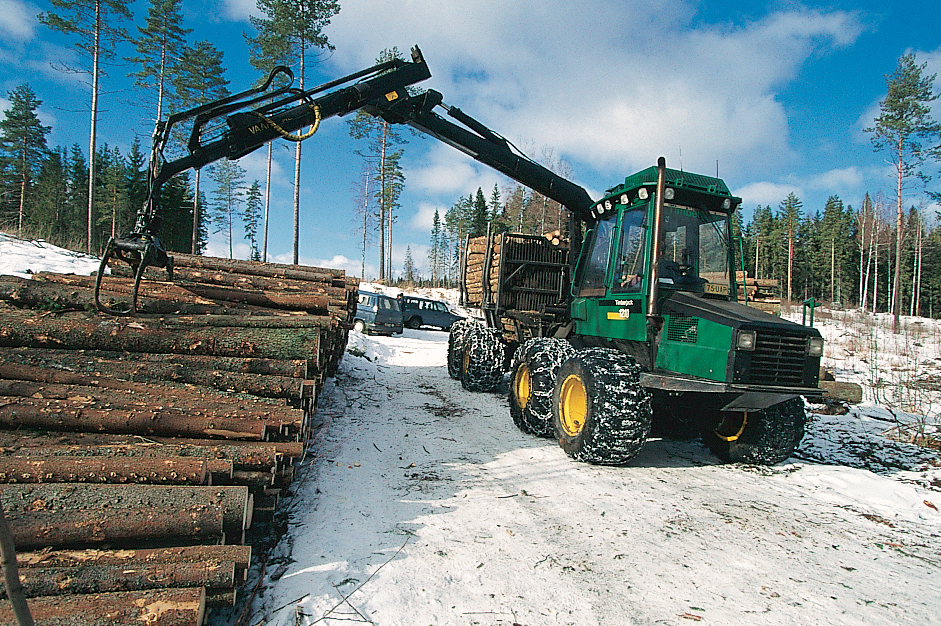
Service industries
are economic activities that provide services rather than produce goods. Service industries account for about 70 percent of Finland’s GDP and employ about 75 percent of its workers. The leading categories of service industry in Finland are community, government, and personal services and also finance, insurance, real estate, and business services. The government controls several large companies in Finland. The country’s hotels, restaurants, and shops are aided by the millions of tourists who visit Finland each year. Many of these tourists come from France, Germany, Sweden, and the United Kingdom.
Manufacturing
accounts for about 15 percent of both Finland’s GDP and its employment. Electrical equipment is a leading category of manufactured goods. Telecommunications equipment is a major contributor to this sector. Nokia, a leading technology company, has its headquarters in Espoo, near Helsinki.
Woodworking, pulp and paper production, and other forest-based industries traditionally have been among Finland’s chief manufacturing industries. Finland is one of the world’s top producers of plywood. The country is also a leading producer of paper and paperboard and wood pulp. Finland’s other major forest products include wood paneling and prefabricated houses, which are erected in factory-made sections.
Machinery also ranks among Finland’s leading manufactured products. The country produces machinery for use in farming and the paper and lumber industries. Finland also produces chemicals, metal products, printed items, processed foods, and transportation equipment.
Agriculture
accounts for less than 5 percent of both Finland’s GDP and its employment. The country’s cold climate and short growing season limit its agricultural production. Most of Finland’s farmland lies in the south and west. The country’s farms tend to be small, though many have increased in size during the 2000’s. Dairy farming and livestock production account for much of Finland’s farm income. The country’s farmers raise beef and dairy cattle, chickens, and hogs. Horses, reindeer, and sheep are also raised. Barley, oats, potatoes, rye, and wheat are important crops. Other crops include rapeseed, strawberries, and sugar beets. Finland’s farmers produce all the cereals, eggs, meat, and milk needed by the people.
Foreign trade.
Finland depends heavily on foreign trade. The country imports about as much as it exports. It imports large quantities of iron and steel, machinery, petroleum and petroleum products, and transportation equipment. Wood, wood products, paper, and pulp make up much of the country’s exports. Other exports include cars, chemicals, electronics, machinery, and steel. 
Finland’s major trading partners include China, Germany, the Netherlands, Russia, Sweden, the United Kingdom, and the United States. In 1995, Finland became a member of the European Union (EU), an economic and political organization of European nations. The EU has removed almost all tariffs and other restrictions on trade between member countries. See European Union (EU).
Transportation.
The government owns almost all of Finland’s railroads. The country has a good network of roads and highways. Helsinki Airport is the country’s busiest airport. The Finnish airline, Finnair, is partially owned by the government. It offers international and domestic flights. As a result of the great distances between many major Finnish communities and the difficulties of travel by land, Finland has one of Europe’s busiest and most extensive domestic air networks. A system of inland waterways connects various lakes and seaports. Sköldvik, near Helsinki, is Finland’s busiest port.
Communication.
Finland’s daily newspapers are privately owned. The largest dailies include Helsingin Sanomat, Ilta Sanomat, and Iltalehti, all of Helsinki; Aamulehti of Tampere; and Turun Sanomat of Turku. Hufvudstadsbladet, a large Swedish-language newspaper, is published in Helsinki.
The government operates the main radio and television networks. Much of the radio and television programming is in Finnish or Swedish. Commercial stations and cable television became popular in the late 1900’s. Finland has high rates of mobile telephone use and internet use, ranking among the leading nations in those areas.
History
Early years.
The ancestors of the Finns and the Sami arrived in what is now Finland more than 5,000 years ago. At first, they lived as nomadic (traveling) hunters and gatherers. The ancestors of the Sami lived in the inland and more northerly areas. The ancestors of the Finns moved into the country from the southern shores of the Gulf of Finland. Their original homeland may have been between the Volga River and the Ural Mountains in what is now Russia. They eventually adopted agriculture and the raising of animals. The Finns gradually pushed the Sami—who continued to rely on hunting, gathering, and fishing—farther and farther north. The early Finns were divided into three loosely organized tribes that often fought one another.
In the 1000’s, Sweden and Russia began a struggle for control of Finland. Both nations wanted to extend their boundaries. In addition, Sweden wanted to convert the Finns to Roman Catholicism, and Russia wanted to convert them to Eastern Orthodoxy.
Swedish rule.
In the 1100’s and 1200’s, Sweden gradually conquered all Finland and established Catholicism as the official religion. Many Swedes settled in Finland, and Swedish became the official language. But Finns shared equal rights with Swedes. In 1593, a general church council held in Sweden made Lutheranism the official religion.
From the 1500’s through the 1700’s, Sweden and Russia fought several wars over Finland. Russia won the Finnish province of Vyborg after the Great Northern War (1700-1721), which was known in Finland as the Great Wrath. For several years during that war and from 1741 to 1743, Russia occupied all of Finland. Sweden and Russia fought over Finland again from 1788 to 1790. After the 1788-1790 war, some Finns began to think Sweden could not protect their land. But a plot to create an independent Finland under Russian protection failed to win wide support. 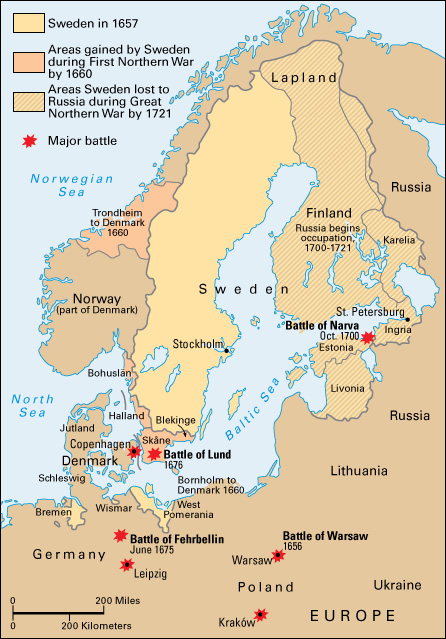
Control by Russia.
In 1808, Russia again invaded Finland. It conquered the country in 1809 and made it an independent grand duchy, but with the czar as grand duke. The duchy had local self-rule based on government systems developed during Swedish control. Russia included Vyborg in the duchy.
During the 1800’s, Finns began to develop feelings of nationalism as they took increasing pride in their country and its culture. In 1835, Elias Lonnrot collected and edited the Kalevala, whose heroic themes strengthened the growing sense of nationalism. Many Finnish leaders began to urge that Finnish be made an official language equal with Swedish. But Finnish did not become a fully equal official language until 1902.
In 1899, Czar Nicholas II began a program to force the Finns to accept Russian government and culture. He took away most of Finland’s powers of self-rule and disbanded the Finnish national army. Russian was made the official language. In 1903, the Russian governor suspended Finland’s constitution and became dictator. Finnish resistance reached a peak in 1905 with a six-day nationwide strike. The czar then restored much of Finland’s self-government. In 1906, the Finns created their first parliament elected by all adult citizens, women as well as men. During the next several years, Russia again tried to Russianize Finland.
Finland stayed out of World War I (1914-1918). But its merchant ships were blockaded in the Gulf of Bothnia, and the country suffered food shortages and unemployment. In 1917, a revolution in Russia overthrew the czar. Finland then decided to declare its freedom.
The new republic.
Finland declared its independence from Russia on Dec. 6, 1917. Russia’s new Bolshevik (Communist) government recognized the new nation, but some Russian troops remained in Finland. In preparing for independence, the Finns had become divided into two groups—socialists, who formed armed units called the Red Guard, and nonsocialists, who formed armed units called the White Guard. Both groups had demanded Finnish independence, but the socialists also wanted revolutionary social changes.
In January 1918, the White Guard, led by Carl Gustaf Mannerheim, began operations in western Finland to expel the Russian troops. Meanwhile, the Red Guard attempted to take over the Finnish government in Helsinki. A bloody civil war broke out between the two groups. The Whites received aid from Germany, and the Reds from Russia. The war ended in a White victory in May 1918.
In 1919, Finland adopted a republican constitution, and Kaarlo Juho Stahlberg became the first president. But Finland’s relations with Sweden and Russia remained unsettled. Finland and Sweden quarreled over possession of the Aland Islands. In 1921, the League of Nations awarded the islands to Finland. Disputes with Russia centered on Karelia, a large region east of present-day Finland. Finland demanded that the eastern part of Karelia be made part of Finland, like the rest of Karelia, or that it be made independent of Russia. Russia did not accept either of these demands, and relations between the two countries remained tense for years.
World War II (1939-1945).
Although Finland never officially allied itself with any nation in World War II, the Soviet Union invaded the country twice. (The Soviet Union had been formed under Russia’s leadership in 1922, and it existed until 1991.) The Winter War began on Nov. 30, 1939, when Soviet troops marched into Finland. Mannerheim led the strong Finnish resistance, which included troops on skis. But Finland had to agree to a peace treaty in March 1940. Under the peace treaty, Finland was forced to give up the southern part of Karelia, where 12 percent of the Finnish people lived. The area made up a tenth of Finland’s territory and included Lake Ladoga and Finland’s second largest city, Viipuri (now Vyborg). The Soviet Union also received a naval base at Hango in the southwestern part of Finland. 
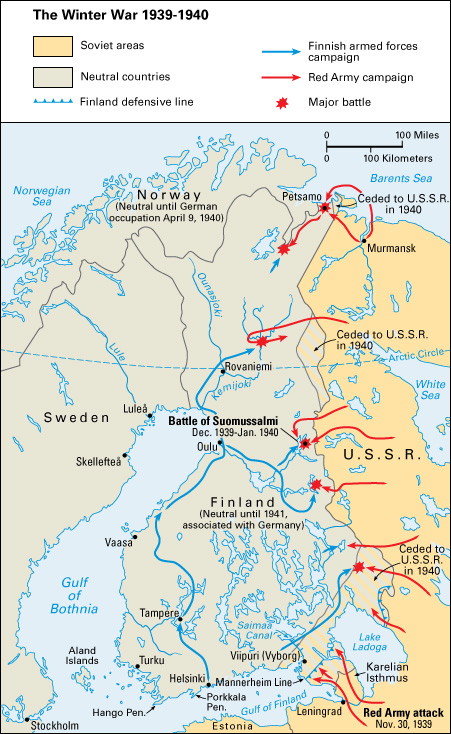
In 1941, Finland allowed Germany to station troops in northern Finland and to move them through the region to attack the Soviet Union. The Soviet Union then bombed Finland, beginning the Continuation War. Finnish troops recaptured southern Karelia. But in 1944, Soviet troops pushed farther and farther into Finland, and the country had to give up. On Sept. 19, 1944, Finland and the Soviet Union signed an armistice. As the German troops retreated from northern Finland, they burned towns, villages, and forests behind them.
The destruction by the Germans made up only part of Finland’s heavy war losses. About 100,000 Finns died, and about 50,000 were permanently disabled. The Soviet Union regained southern Karelia and won other Finnish territories as well. The Soviet Union also leased a military base at Porkkala, near Helsinki, but gave up its base at Hango. About 420,000 Karelians fled to Finland, where the government gave them new land. Finland also had to pay the Soviet Union large reparations (payment for damages). See Russo-Finnish wars.
Postwar developments.
Mannerheim became Finland’s president in 1944, but he retired in 1946 because of poor health. Juho K. Paasikivi finished Mannerheim’s term and was elected to a full term in 1950. Paasikivi set a policy of Finnish neutrality in international politics. Under him, Finland also developed close economic and cultural ties with the Soviet Union, Denmark, Norway, and Sweden. In 1955, the Soviet Union returned Porkkala to Finland, and the two nations renewed a 1948 treaty of friendship and assistance.
Also in 1955, Finland joined both the United Nations and the Nordic Council, which includes Denmark, Iceland, Norway, and Sweden. Citizens of Nordic Council countries may work and receive social benefits in any member nation, and they may travel among member nations without a passport or visa. As a result, many Finns have moved to Sweden, which has a more developed economy and more social welfare benefits than Finland has.
In 1956, Urho Kekkonen was elected president. He continued to emphasize neutrality in international affairs and was reelected in 1962 and 1968. Finland joined the European Free Trade Association (EFTA), an economic organization, as an associate member in 1961 and became a full member in 1986.
The late 1900’s.
During the late 1970’s and early 1980’s, Finland completed construction of four nuclear power plants. These plants supply about a third of the nation’s energy needs. Finland worked to improve the economy in the underdeveloped north and so relieve overcrowding in the booming south.
In January 1973, Finland’s parliament passed a bill to extend Kekkonen’s term from 1974 to 1978. Kekkonen was reelected in 1978. In September 1981, he took a medical leave from office and Prime Minister Mauno Koivisto became acting president. Kekkonen resigned from office in October 1981 because of poor health. Koivisto was elected president in January 1982. Kekkonen died in 1986. Koivisto was reelected in 1988. In 1994, Martti Ahtisaari was elected to succeed him.
Finland withdrew from EFTA and joined the European Union (EU) in 1995. The EU works for economic and political cooperation among its member nations. In 1999, Finland began using the euro, the EU’s basic monetary unit.
Recent developments.
In 2000, Finland elected its first woman president, Tarja Halonen. In 2003, Matti Vanhanen became head of the ruling Center Party and prime minister of Finland. Mari Kiviniemi replaced Vanhanen in 2010, becoming Finland’s second female prime minister. The first female prime minister, Anneli Jäätteenmäki, had served briefly in 2003. 
The conservative National Coalition Party (NCP) won parliamentary elections in 2011, and Jyrki Katainen became prime minister. In 2012, Sauli Niinistö became the first NCP president since 1956. Fellow NCP member Alexander Stubb replaced Katainen as prime minister in 2014. In 2015, millionaire businessman Juha Sipila became prime minister after his Center Party won parliamentary elections. Social Democrat Antti Rinne briefly succeeded Sipila in 2019, before resigning late in the year. Rinne was succeeded by fellow Social Democrat Sanna Marin in December. In 2023 elections, the NCP won a close victory over the nationalist Finns Party and the Social Democrats. The NCP formed a coalition that included the Finns, the Christian Democrats, and the Swedish People’s Party of Finland. NCP leader Petteri Orpo became prime minister.
The Russian invasion of Ukraine in 2022 prompted the leaders of Finland and its neighbor Sweden to apply that year for membership in the North Atlantic Treaty Organization (NATO). Finland became a NATO member in April 2023.
Former prime minister Alexander Stubb won a runoff election in 2024 to succeed Sauli Niinistö as president. Stubb’s competitor in the runoff was Pekka Haavisto, a former foreign minister.
